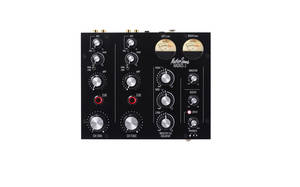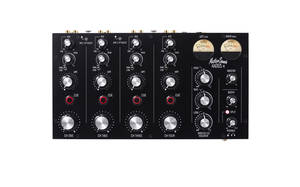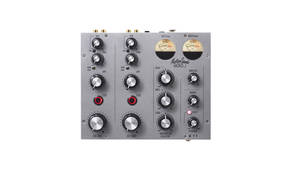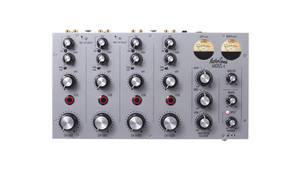I know all come here for an endless slew of boundary-pushing evolutionary DJ shiny. And for the longest time, that’s what happened. But as the tech race slows down, and the drawing boards fail to yield the next big thing, attentions turn to making things better, which in turn offer benefits to new users. And that’s precisely what the Mastersounds Radius 2 and Radius 4 V3 rotary mixers bring.
This explains everything:
MASTERSOUNDS LAUNCHES THIRD GENERATION RADIUS DJ MIXERS AT A NEW PRICE POINT
Boutique UK mixer brand, MasterSounds, has launched a third generation of its highly successful Radius 2 and Radius 4 DJ mixers, which contain various technology enhancements and sport a new competitive price tag.
Originally launched in 2016, the two-channel Radius 2 rotary DJ mixer became an instant hit with the high-end DJ and club installation community, and was followed by the introduction of the four-channel Radius 4 mixer, two valve-based versions (the Radius Two and Four Valve), an FX unit and dedicated LinearPOWER supply accessory.
“Four years on, and the brand has seen remarkable growth but the higher production costs of a premium rotary mixer rule them out for DJs on a tighter budget,” explains MasterSounds’ founder, Ryan Shaw. “Designer, Andy Rigby-Jones, and I decided to do something about it, by redesigning the compact Radius 2 and Radius 4 to make them more affordable but without compromising any of the features, the feel, or the audio fidelity of the original model.”
The new generation Radius 2 and 4 offer clean, open, and dynamic sonic quality on both LINE and RIAA inputs, as well as improved usability. Both mixers feature easy-reading analogue VU meters, a responsive Master EQ/Isolator, a smooth natural sounding hi-pass filter on each channel, and an AUX send/Return system with insert button for easy integration of external effects, including MasterSounds own FX unit. Radius 4 also includes 2 mic inputs, selectable via the rear panel.
“The redesign challenge meant going back to the drawing board to see where we could simplify the circuitry without impairing performance. For instance, the Split Composite Passive RIAA stage remains identical to the previous generation but we have simplified the post-fader circuitry. The biggest change was to the internal construction and PCB board shapes, where we have optimised them for maximum efficiency through our in-house fabrication plant which has made them a lot easier to manufacture. What we haven’t compromised on is the quality of the components used, and the third generation mixers all feature Alps pots/switches, close tolerance resistors/capacitors, and Panasonic electrolytics. I am very happy with the result of the engineering changes, and these compact mixers offer exceptional value for money,” explains Union Audio’s Andy Rigby-Jones.
Union Audio has undergone radical changes since Radius 2’s inception four years ago, which has enabled the team to implement the new design changes. Moving into a new unit in 2017, Rigby-Jones has developed a sophisticated design and production facility, coupling traditional analogue engineering with ultra-high specification manufacturing.
“The Radius 2 and 4 hold a special place in my heart, it’s the mixer Andy and I began our audio journey with, and one that gives the user a really unique way of blending records. Both Radius 2 and 4 are desktop products, with a small footprint, which makes them perfect for home, touring, and club use, or all three! It was the right time to re-engineer Radius, giving more DJs the opportunity to experience our wonderful product, at a price unseen given each mixer’s quality of build and fidelity of sound,” concludes Shaw.
New pricing is Radius 2: £799 and Radius 4: £1089.
For more information, please visit: www.mastersounds.co.uk
Better, not more
This is what I’m all about — taking something and improving it. My obsession with site speed is a testament to this, so I absolutely get where Ryan and Andy are coming from in making these changes to Mastersounds products. Side note — loving the Mastersounds logo on the meters.
The price drop is an interesting move. Because the price point for rotaries is naturally higher because of the limited runs, I’m not convinced that Mastersounds needed to drop the price. From what I can gather, it’s a hugely successful product range as it is. They could have kept the price the same and enjoyed a wider profit margin.
But it’s possible that they’re feeling a little pressure from Omnitronic’s TRM-402 and TRM-202 rotary mixers. While we haven’t had them in for review, for buyers wanting a rotary, they lower the price bar considerably, and from the reviews I’ve perused will definitely give the casual buyer the rotary experience they want.
I like this move because for me it indicates bigger and better things will be coming from Mastersounds.








Regarding the title of this article: “Cheaper” most def, but “better”..? How are the MK3’s better than the MK2’s? There’s no word about that in the press release. Maybe MasterSounds replaced the MUSE01 opamps with other (cheaper) ones. There are a lot of people owning a MK2 R2/R4 who would like to know this, since it determines the resale value of their mixers. Would be nice if this can be cleared up.
Fair point — apologies for the unintentionally vague headline. And you reminded me that I missed off a point about existing owners not needing to upgrade.
For me they’re better from a manufacturing perspective. Such a price drop however may well impact on resale prices of existing ones.
I think for current MK2 owners the problem of the headline is that people will think the MK3 is better from a user perspective (better sounding for one). This will inevitably lead to devaluation of the MK2, while there is a reasonable change that the MK2s are actually better sounding. It would be good if maybe MasterSounds can chime in on this.
Based on your feedback I fixed the headline to be more accurate. Thanks for chipping in. :)
No problem, thank you for listening :) But to be very honest, “internal improvements” to me still implies “better sound”. I know MasterSounds mentions “various technology enhancements” but that’s rather vague. People who are in the market for a mixer like this or own the previous version, really would like to know what has been improved exactly..
Probably if they put better components they would tout it in their press release with more precision on what components are better. Most probably it’s the opposite.
yeah, I think so too..
Would be interesting to see how the Omni 202/402 compares. I haven’t read many good reviews on their reliability from poking around the web. I’m in the market for a rotary as I want to replace the Xone 43c (hate the upfade curve that can’t be adjusted).
I found a 202 for £300 and was tempted.
Big fan of the price drop. I’m tempted to buy now. But I’m in the minority that wishes it had a master cue switch or blend knob :(
:edit: Nvm, I guess when no cue is selected it routes to the master. If that’s the case then SOLD!!!
How much was Radius 2 MK2?
I pulled the trigger on the Radius 4 within an hour of them announcing it, was waiting for what I thought was them in lockdown but turns out the team have been working hard to bring this out. The price reduction is great for me as I’m not that into sound to care too much about the components used.. I dare say Ryan and Andy wouldn’t let one of these out of the door unless it still sounded great.
I’ve wanted a Rotary for over 20yrs since I first clapped my eyes on the Rane setup at the Empire in Middlesbrough and can finally get my hands on one properly.
When you get to this level (and pretty much the 96/V10/MODEL1/etc), ‘sound quality’ is such a negligible argument. You’ve got all these rotary and high end mixer fans frothing at the mouth about which one is better, but it’s at the point where you need electrical analysis equipment to notice the difference.
Absolutely agree, and I’d even extend the range beyond high end models too. I always view sound quality in the context of environment and audience. And while I’m sure that golden eared DJs might be able to pick a 92 over a DJM-900 in controlled A-B listening, I’m utterly convinced that your average shitfaced clubber couldn’t tell a Blue Dog from a MODEL 1 on a dance floor in your average club.
This is true.. strangely in the bar i DJ in (outside terrace with full sound system etc) ive found my DDJ-SX2 gives out a nicer sound to the system than the bars own DJM-900, yet people will argue the 900 is bound to be better as its twice the price of the controller, and controllers are all kids toys apparently. I prefer searching for tracks on the laptop over CDJs, hence why i take my own in when i can, otherwise if we are B2B or i cant be bothered ill use the bars kit but i find it seems to ‘hammer’ the system more than my controller does to achieve the same volume.
Would be nice if they made a new 4V model with the FX unit built in or at least with built-in HP/LP filters.